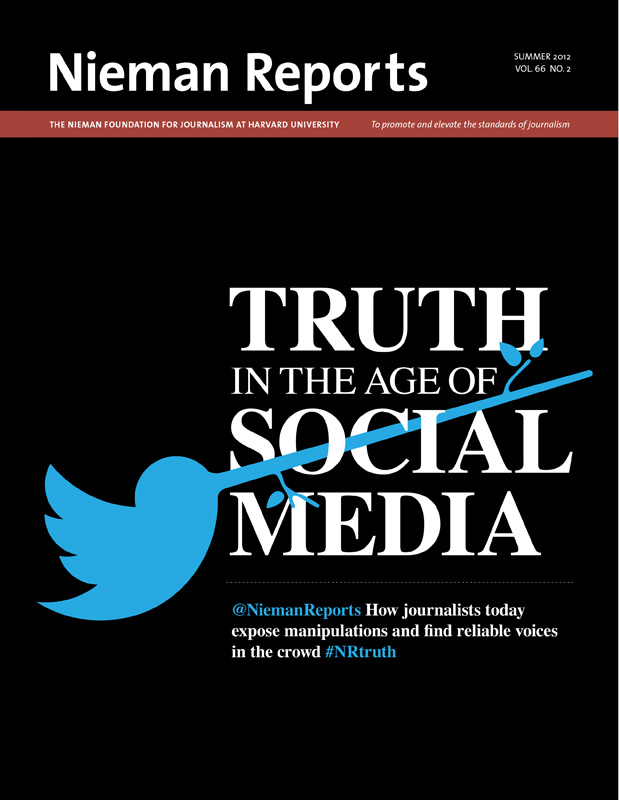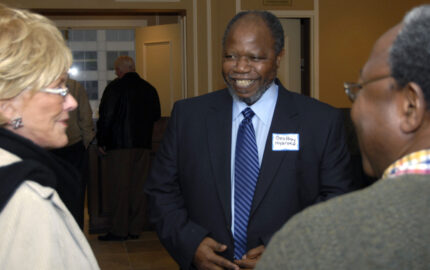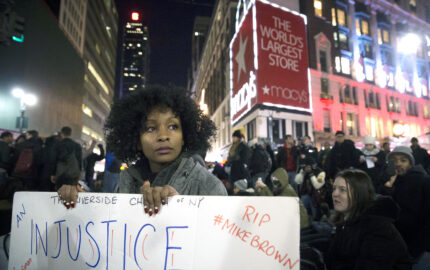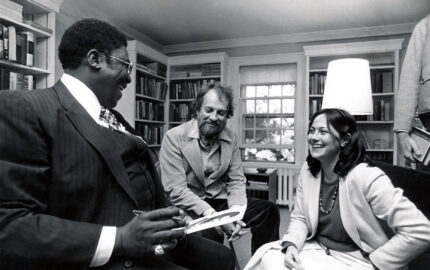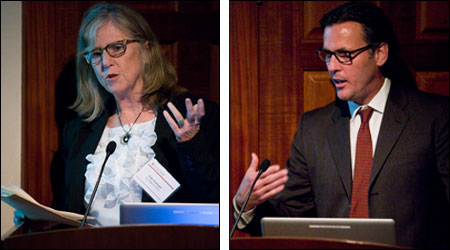
Los Angeles Times reporters Gale Holland and Michael Finnegan constructed a narrative of the corruption they discovered by piecing together e-mails they obtained. Photos by Brooks Canaday.
A centerpiece clock tower that was lopsided. A rooftop track and field rendered unusable by design flaws. A feeding trough set too high for the pig to reach. From major to mundane, construction flaws plagued the $5.7 billion program that Los Angeles voters authorized to rebuild the city's community colleges. But after reporters Gale Holland and Michael Finnegan spent 18 months investigating for their Los Angeles Times series "Billions to Spend," it became clear that the real story wasn't the flaws, but the corruption, greed and hubris that had created them.
In April the series received the Nieman Foundation's 2011 Worth Bingham Prize for Investigative Journalism. Prize judge Walter Robinson, formerly a longtime Boston Globe investigative reporter, called it "a stark reminder of the importance of the watchdog role the press plays when government spends scarce public funds. This was an important public works project whose biggest beneficiaries should have been working class community college students," Robinson said. "Instead, the funds were used to award lucrative contracts to politically connected companies, with lax oversight."
Edited excerpts of the reporters' discussion at the ceremony follow; a full version is also available.
Gale Holland: I'm a higher education reporter, and I got a tip that the elected trustees of the college system had fired the chancellor because he opposed these outlandish renewable energy projects. Meanwhile Michael [Finnegan], who's a political reporter, got a tip that a newly renovated theater was going to be torn down, and a new one built, just because they had enough money to do it. We met with our editors, and the conclusion was that the elected trustees were basically invisible in L.A., allowing them to spend $5.7 billion in the dark of night, without any oversight. So they set us loose to take a comprehensive look at the program.
We went about trying to get the public records that would detail exactly what the construction problems were and exactly how much they cost. Our focus was to be very specific and to rely on public records, but for a year they gave us nothing. Finally, we had the bright idea of asking for the e-mail between the public officials and these contractors, architects and construction managers. When it arrived, in the attachments were all of the reports we had been seeking—all the engineering reports, and even a confidential legal settlement. So we put it all in a file and called it "Nirvana," because it was everything we needed.
E-mail was really a mother lode for our project. They delivered a lot of the e-mail in an Outlook format so it was word-searchable, which saved us tons of organizational work. It set up the chronology of when and how things happened. And more importantly, it created a narrative, because this e-mail was all architects, contractors and managers arguing over what went wrong, and whose fault was it, and accusations back and forth, so we had more of a story, with human beings talking, and we didn't have to rely just on the public records reports to document the problems.
We discovered that there were secretaries and PR people who were on the payrolls of shell companies that were owned and run by big campaign donors for the district. They were charging very fat markups, ostensibly to cover their business overhead and a small amount of profit. In one example, the district was paying about $300,000 for somebody who was writing press releases, but that employee himself only made about $65,000. The rest of it went to these layers of private companies. That particular employee happened to be a nephew of one of the college trustees.
Michael Finnegan: My first job was reporting in New Jersey and New York, where I had done some investigative work and some political work. So my assumption when we couldn't get questions answered was that something must be wrong here, somebody must be on the take. Los Angeles is largely a Democratic Party town where environmentally friendly programs are kind of a given, and it wasn't unheard of for contracts to go to people as political favors in the green energy world.
It turned out, though, that it was not a standard story of public officials ripping off the public. It was a much more interesting story. It was about Larry Eisenberg, who was in charge of the program. It was about his ego, partly. He fashioned himself to be the Robert Moses of green construction in California.
Eisenberg spent two, three, four, five hours with us, trying to explain what they were doing, putting up these solar panels and windmills all over the campuses. Somehow they were going to generate so much electricity that they would no longer have to pay power bills, and the power costs would go down to nothing. Something didn't add up though, because renewable energy is more expensive than the traditional kind.
For us, it didn't matter how convoluted and detailed this was, anything—the construction of a rocket ship, say—could be explained if you just took enough time to listen to the people who were explaining how it was done. They couldn't do it—it was Alice in Wonderland. Finally, after he said, "Part of the plan is such-and-such," I just asked him: "What plan?"
Of course, there was no plan.
